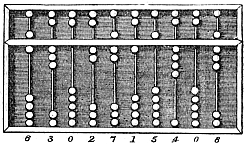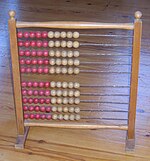This is an old revision of this page, as edited by TaiwanBot (talk | contribs) at 23:33, 22 June 2005 ((Robot-assisted disambiguation: China)). The present address (URL) is a permanent link to this revision, which may differ significantly from the current revision.
Revision as of 23:33, 22 June 2005 by TaiwanBot (talk | contribs) ((Robot-assisted disambiguation: China))(diff) ← Previous revision | Latest revision (diff) | Newer revision → (diff) This article is about the calculator. For the flat slab at the top of a column, see ].An abacus is a calculation tool, often constructed as a wooden frame with beads sliding on wires. It was in use centuries before the adoption of the written Arabic numerals system and is still widely used by merchants and clerks in China and elsewhere.
Chinese abacus
The suanpan (simplified Chinese: 算盘; traditional Chinese: 算盤; pinyin: suànpán) of the Chinese is similar to the Roman abacus in principle, though has a different construction.

The Chinese abacus is typically around 20 cm (8 inches) tall and it comes in various widths depending on the application. It usually has more than seven rods. There are two beads on each rod in the upper deck and five beads each in the bottom for both decimal and hexadecimal computation. The beads are usually rounded and made of a hard wood. The beads are counted by moving them up or down towards the beam. The abacus can be reset to the starting position instantly by a quick jerk along the horizontal axis to spin all the beads away from the horizontal beam at the center.
Chinese abaci can be used for functions other than counting. Unlike the simple counting board used in elementary schools, very efficient suanpan techniques have been developed to do multiplication, division, addition, subtraction, square root and cube root operations at high speed.
Bead arithmetic is the calculating technique used with various types of abaci, in particular the Chinese abacus.
See Chinese abacus for more information.
Roman abacus

The Late Empire Roman abacus shown here in reconstruction contains seven long and seven shorter grooves, the former having up to five beads in each and the latter one.
The groove marked I indicates units, X tens, and so on up to millions. The beads in the shorter grooves denote fives—five units, five tens, etc., essentially in a bi-quinary coded decimal system, obviously related to the Roman numerals. The short grooves on the right may have been used for marking Roman ounces.
Computations are made by means of beads which would probably have been slid up and down the grooves to indicate the value of each column.
See Roman abacus for more information.
Japanese abacus
The Japanese eliminated (first) one bead from the upper deck and (later) another bead from lower deck in each column of the Chinese abacus, the Japanese eliminated the use of Quichu (Chinese division table). The method of Chinese division table were still used when there were 5 lower beads. There came the war of Multiplication table versus Division Table. The school of Multiplication table prevailed in 1920s. The rods (number of digits) increase to usually 21, 23, 27 or even 31, thus allow calculation for more digits.
That "modernization" makes the Japanese soroban (算盤) (apparently) more compliant to the decimal system than the Chinese Abacus.
Soroban is taught in elementary schools as a part of lessons in mathematics. When teaching the soroban, a song-like instruction is given by the tutor. The soroban is about 8 cm (3 inches) tall. The beads on a soroban are usually shaped as a double cone (bi-cone) to facilitate ease of movement.
Ironically, the primary students bring along with them two soroban, one of 1 upper bead and 5 lower beads, the other of 1 upper bead with 4 lower beads, when they learn soroban in school!
The size of beads of soroban is standardized, the Japanese classified soroban for native Japanese and foreigners, as Western people are of bigger body build and hands/fingers. The soroban that are for foreigners (Westerners) are made with plastic pipe on on both left and right side of the frame, while that that for native Japanese were all made with all wooden frame. In this way the "thickness" of the soroban (for foreigners) is higher, render it easier for the non-Japanese to manipulate.
http://www.syuzan.net/english/history/history.html
https://www.soroban.com/deal_eng.html
https://www.soroban.com/d3.html

Russian abacus
The Russian abacus, the schoty or sjotty (счёты), usually has a single slanted deck, with ten beads on each wire (except one wire which has four, and acts as a separator or for fractions). This wire is usually near the user. The Russian abacus is often used vertically, with wires from left to right in the manner of a book. The wires are usually bowed to bulge upward in the center, in order to keep the beads pinned to either of the two sides. It is cleared when all the beads are moved to the right. During manipulation, beads are moved to the left. For easy viewing, the middle 2 beads on each wire (the 5th and 6th bead) usually have a colour different to the other 8 beads. Likewise, the left bead of the thousands wire (and the million wire, if present) may have a different color.
The Russian abacus is still in common use today in shops and markets throughout the former Soviet Union, although it is no longer taught in most schools.
Native American abacus
Some sources also mention the use of the abacus in ancient Mayan culture. The Mesoamerican abacus uses the 5-digit base-20 Mayan numeral system.
The khipu of the Inkas was a system of knotted cords used to record numerical data - like advanced tally sticks - but was not used to perform calculations.
School abacus

Around the World, abaci have been used in elementary schools as an aid in teaching arithmetics. In Western countries, a model similar to the Russian abacus and often known as a bead frame has been common (see image).
Computers
A computer is an automatic electronic abacus. Some early computers used ten switching elements per numeral, but a modern computer is a binary abacus.
Uses by the visually impaired
Abaci are still used by individuals who have visual impairments. They use an abacus to perform the mathematical functions multiplication, division, addition, subtraction, square root and cubic root. A piece of soft fabric is placed behind the beads so that they don't move inadvertently. This keeps the beads in place while a person feels the beads or uses the abacus.
See also
- Slide rule
- Napier's bones
- History of computing
- History of computing hardware
- Nepohualtzintzin (Native American abacus - Aztec)
- Abacus logic
- Mental abacus
- Positional notation
External links
- Abacus in Various Number Systems
- Soroban in Various Number Systems
- Suan pan in Various Number Systems
- Abacus Article about abacus from the 11th edition Encyclopedia Britannica (1911).
- Abacus
- Abacus: Mystery of the Bead - An Abacus Manual
- Advanced Abacus Techniques
- Lee Kai-chen's Improved Abacus
- Soroban
- Soroban Abacus Handbook A guide to addition, subtraction, multiplication and division.
- Suan Pan
- Webarchive backup: Mesoamerican abacus (this site is no longer online - but the webarchive backup is; however, one of the author’s documents comparing the organization and use of the Mesoamerican abacus and the Chinese abacus is mirrored at ); see also
- Roman abacus
- Abacus Photos and Images
- The World’s Smallest Abacus
- Java applet of Chinese, Japanese and Russian abaci